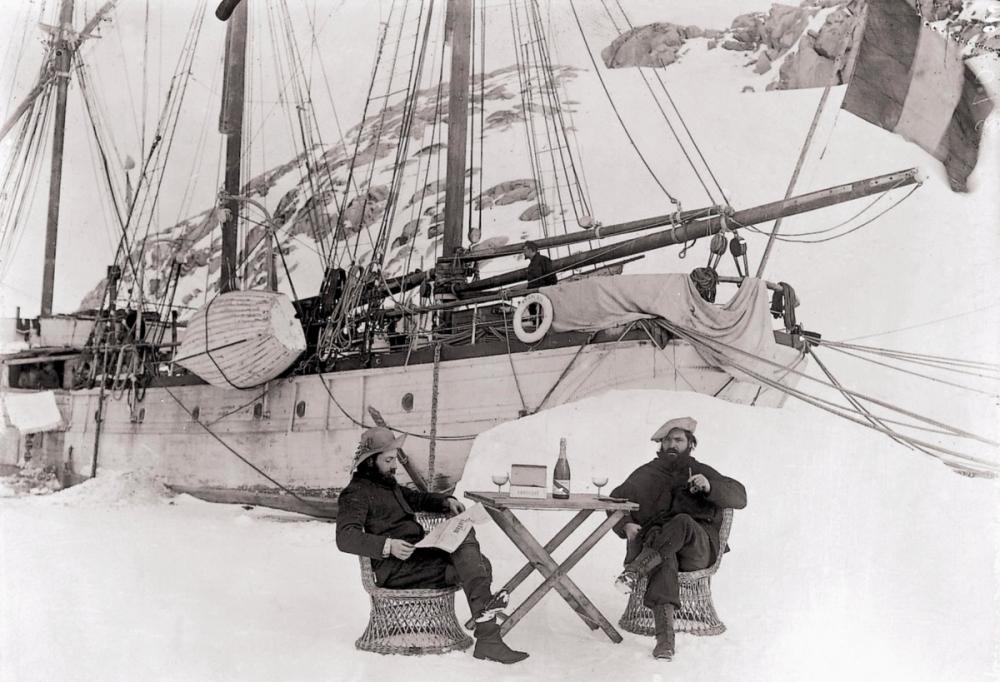“We won’t be able to try this on earth of course, but if they ever market the same cuvée in a normal Champagne bottle, I highly recommend that you try it,” writes Sadler.

The Mumm Stellar launch (l-r) Lionel Suchet (Directer general of CNES), Michael Suffredini, (Axiom Space’s president & CEO), César Giron (President of Maison Mumm), Laurent Fresnet (Maison Mumm cellar master), Octave de Gaulle. © Quentin Sadler
It all started with a photograph of the 1904 French Antarctic Expedition led by famed French explorer Jean-Baptiste Charcot. In typical French style Charcot wanted to take some little touches of civilisation with him. So, as well as gloves, furs and sledges he packed wicker garden furniture, a Panama hat and Mumm Cordon Rouge Champagne.
The photograph shows two members of the expedition, Ernest Gourdon and Paul Pleneau, drinking a glass of Mumm Champagne in Antarctica on Bastille Day 1904.

Ernest Gourdon & Paul Pleneau in Antarctica on Bastille Day 1904
This wonderful image inspired the good people at Mumm to think about challenges that are starting to appear in our modern world. As space travel becomes more common in the coming decades, as humans start to explore further into the cosmos, then how do we stay connected to the rituals and pleasures of our way of life?
For Mumm and Charcot, one of these rituals is enjoying a glass of Champagne. As Jean-François Clervoy, an astronaut with the European Space Agency and veteran of three NASA space missions says: “In space, it is essential to maintain a link with earth and its culture.”
The problem is, of course, that you cannot simply take a bottle of champagne into zero gravity and nor can you open it once you are there. The wine reacts quite differently in space too, with subdued aromatics and flavour as the bubbles do not rise to the surface and so do not release the aroma molecules they contain. In addition the wine leaves the bottle as a ball of foam, which is how it would be ingested.
In 2017, with the idea of space travel becoming more important, Mumm decided to address these problems and to create a Champagne that would comply with space cargo specifications as well as AOC Champagne regulations.

The Paris Observatory © Quentin Sadler
There followed five years of research and development in collaboration with CNES (Centre national d’études spatiales)– the French government space agency, and Axiom Space. Axiom is a privately funded American space company that has sent private spaceflights to the International Space Station and aims to operate the world’s first commercial space station from 2024.
Mumm’s chief winemaker, Laurent Fresnet, was given the task of creating a cuvée that would enable humans to enjoy Champagne in zero gravity. He did this by ageing the liqueur d’expédition in oak barrels and keeping the finished wine sur latte for five years. They named the result Mumm Cordon Rouge Stellar and I tasted this together with the standard Mumm Cordon Rouge at last week’s launch at the Paris Observatory.
The result is a wine that is recognisably a Mumm Champagne, but is bolder, more mouth-filling and spicier, with richer fruit and more vibrant acidity than the terrestrial version of Mumm Cordon Rouge. Remember, when the astronauts taste it, the aromas and flavours will feel much less intense.

Champagne Jim, but not as we know it
Now they needed a bottle in which to take it into space. This part of the project was undertaken by Octave de Gaulle who designs objects that allow humans to really live in space and not just to survive there. The bottle that he has created is a stunning object of desire that echoes the traditional Champagne bottle we use here on earth. It is a half glass bottle contained in a protective shell made of aeronautical-grade aluminium with a stainless steel opening and closing device, which regulates the wine leaving the bottle.
We won’t be able to try this on earth of course, but if they ever market the same cuvée in a normal Champagne bottle, I highly recommend that you try it. As you drink, why not gaze up at the stars and raise your glass to the people who created this Champagne as well as those intrepid explorers who are just starting out on mankind’s journey to inhabit space.
Quentin Sadler is a wine writer, wine educator and mapmaker.
































